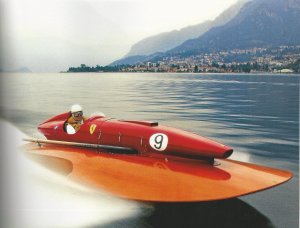Simanaitis Says
On cars, old, new and future; science & technology; vintage airplanes, computer flight simulation of them; Sherlockiana; our English language; travel; and other stuff
A TRIO OF THREE-POINT RACERS
A HYDROPLANE is the high-performance sports machine of the aquatic world. Because of its specially contoured hull, once the craft is “on plane” it touches the water in only three points, a lateral pair up forward and a single blade of its spinning propeller.
It’s an impressive balancing act, displayed here by a trio of the genre, one with Ferrari power, another honoring American hot rods and scads of the third snarling around Japanese stadiums.

1957 San Marco Ferrari KD800. This and other images of this craft from Octane, March 2015.
The March, 2015, issue of the British magazine Octane gives full details of this Ferrari-engine hydroplane, the provenance of which is impressive indeed. Its 4494-cc dohc V-12 had already powered a Ferrari 340MM coupe at the 1953 Le Mans, the Spa 24-hour race and Mexico’s 2000-mile Carrera Panamericana.
A deadly crash in the Mexican road race left only the engine salvageable. In 1957, the powerplant was bought by Italian adventurer/chainstore owner Guido Monzino who commissioned its use in an 800-kg-class hydroplane built by Milanese boatbuilder San Marco.

The Monzino boat’s transom-mounted rudder assembly and twin-blade propeller can be seen bathed in Lake Como water.
Monzino would commute from his Lake Como villa to the Como Yacht Club, where his Ferrari awaited for the drive down to his office in Milan. By the late 1960s, the thrill apparently wore off and the boat, registered as KD800, languished in storage.
In 1969, Austrian Dody Jost, a student at the Fine Arts Academy of Milan, bought KD800. In time, he began a lengthy restoration, the beauty of which is shown here.
Two other Ferrari-engine hydroplanes were built, albeit with powerplants dedicated to marine use. One, the 1953 Timossi-Ferrari Arno XI, went 150.2 mph on northern Italy’s Lake Iseo, a record that remains unbroken in its class. The Arno XI can be seen in action.
The Timossi-Ferrari was a star of the RM Sotheby’s Monaco Auction, May 2012, where it fetched €868,000 ($1,085,000). There are models of the Arno XI, ranging from a hardwood handbuilt limited edition from the Ferrari Store ($7450) to a plastic radio-controlled model from Carrera ($229.99).

1947 Lauterbach-Ford V-8 Racing Hydroplane. This and the following image from Brooks Summer Vintage auction catalog, June 1993.
Predating and in contrast to exotic-engine hydroplanes, the 1947 Norman-Lauterbach-designed Lyndora is powered by a product of American ingenuity, a classical flathead Ford. This V-8 displaces 221 cu. in., 3.6 liters, and carries all the hot-rod mods of the era. It has aluminum cylinder heads and a three-carburetor inlet manifold, both from aftermarket specialist Edelbrock; twin-choke downdraft Solex carbs are fitted.
Piloted by its builder Bob Roland, Lyndora had success in National 220 Class racing. It passed through several owners, was restored, shipped to Britain and appeared in the Brooks Summer Auction at Goodwood House in June 1993. Lyndora currently resides at the Classic Boat Museum, in Cowes, on the Isle of Wight.
Contrasting with Ferrari or Ford engines are outboards in small hydroplanes snarling around stadiums in Japan. In two dozen venues around the country, boat racing, 競艇, Kyōtei, is one of Japan’s most popular spectator sports.

These windows are all for placing bets at one boat-racing venue. This and other images from UnmissibleJAPAN.com.
Boat racing’s popularity in Japan is in part attributable to its being one of only five sports with legalized betting (the other four are horse, bicycle and motorcycling racing and football). Despite its popularity, Kyōtei has a less than laudable image in Japan, akin to dog racing in the U.S.
Courses are standardized by the Boat Racing Federation and are the same throughout the country. A venue is 400 meters (a tad less than 1/4 mile) in length and 150 meters (not quite 500 ft.) wide. Buoys 300 meters (about 1000 ft.) apart mark the turnarounds.
Six boats participate in each race, each driver wearing livery that matches his or her boat’s flag. And, yes, about 10 percent of the boat racers are women, who compete equally with men and also have women-only events.
The Boat Racing Federation requires a year of training for race drivers, and there’s fierce competition for admission to its Academy. Of a typical annual batch of 2000 applicants, all from 15 to 29 years old, most weighing less than 135 lb., only around 60 are accepted. The Federation covers most of the training costs. However, its rigors cause more than a third of the prospective racers to drop out.
I like the Academy’s motto: “Strictness in training, cheerfulness in livelihood.” ds
© Dennis Simanaitis, SimanaitisSays.com, 2015






